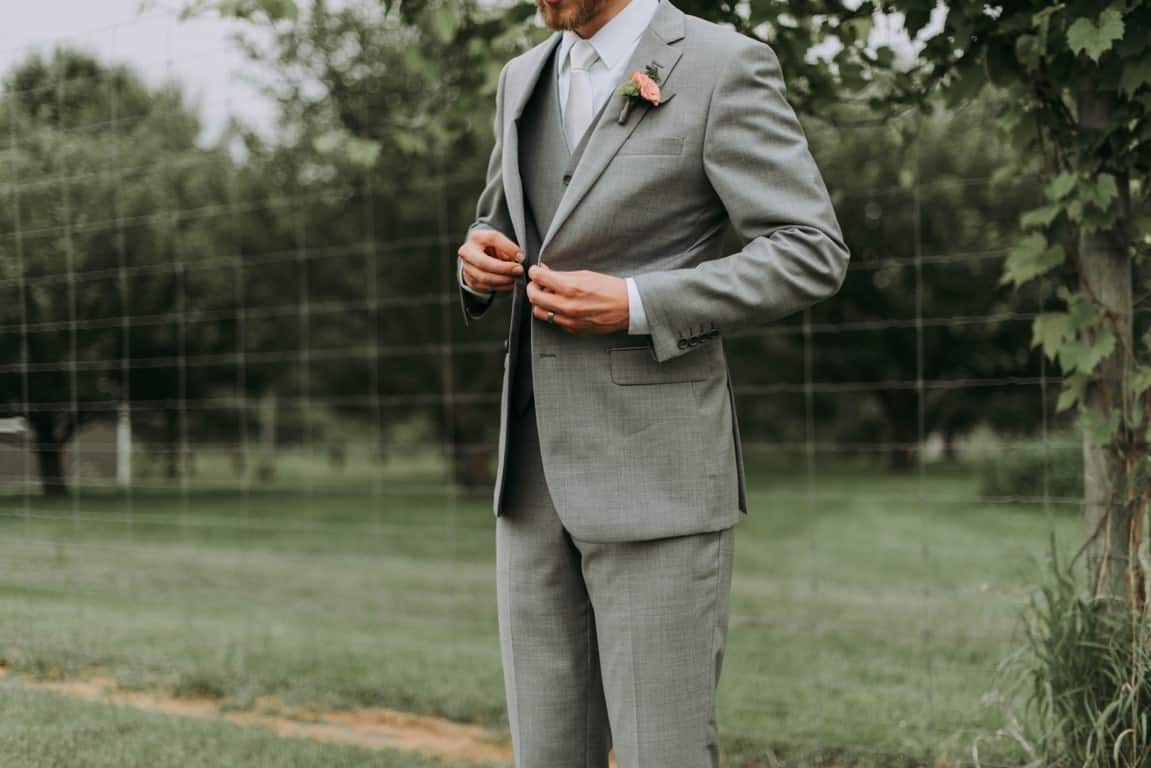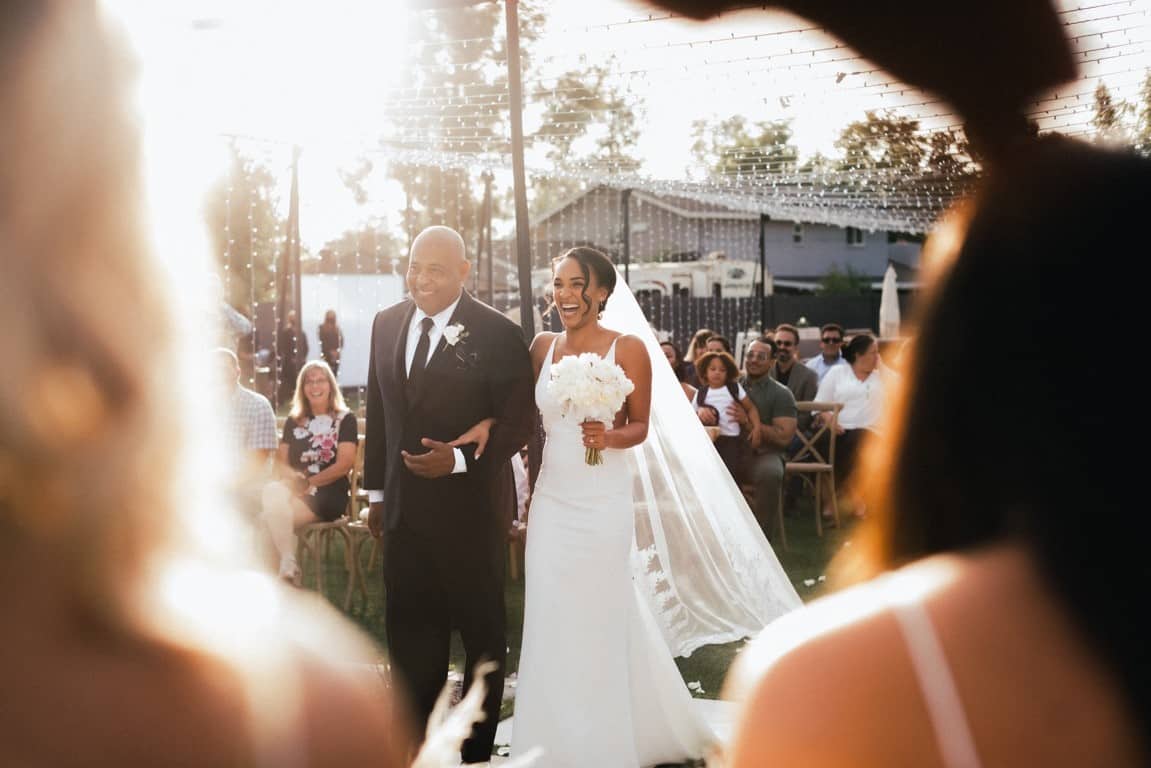Marriage as a social institution has been present since time immemorial. Over the years, diverse wedding traditions have emerged as a result of varying cultures. People are constantly revising and reworking these traditions to fit contemporary beliefs and values.
The tradition of “giving away the bride” has a complicated historical root. Its meaning may make some people uncomfortable, which necessitates finding modern alternatives to “giving away the bride.”
The tradition and its historical roots are explained below. Afterward, alternative ways to word the tradition during a ceremony are given, providing alternative wording for giving away the bride. Modern changes you can make to the tradition are also enumerated.
What is the Giving Away the Bride Tradition?

When the bride walks down the aisle, she is usually escorted by her father. The tradition of “giving away the bride” refers to the moment when they reach the end of the aisle, and the father hands his daughter over to the groom.
A major reason why couples want a modern alternative to the “giving away the bride” tradition is because of its roots. Historically, unmarried women “belonged” to or were the “property” of their fathers. In exchange for her hand in marriage, a prospective groom would pay some form of dowry to the woman’s family.
With the practice of dowry already antiquated, the tradition itself has taken more modern forms. At its core, the “giving away the bride” tradition is just one of the many ways a family can show their love and support for the couple getting married.
Alternative Wording for Giving Away the Bride

Selecting the right giving the bride away wording is vital for the ceremony’s atmosphere. The phrases listed below offer respectful and considerate alternatives, ensuring the language used honors both the bride and the familial bonds being celebrated:
1. Who gives their consent for this bride to marry this groom today?
2. Who gives this woman’s hand in marriage to this man?
3. Who presents this woman to be married to this man?
4. Who brings this woman to be married to this man?
5. Do you willingly and wholeheartedly present this bride to be wed to this groom today?
6. Does the bride have her parents’ blessing and consent to be married to this man today?
7. Who supports the marriage of this woman to this man today?
8. Who gives their permission for this woman to marry this man today?
9. Who stands with this woman to represent her family’s culture and traditions?
10. Do the parents of this woman entrust her to this man as they come to solemnize their union?
How Should the Parents Respond?
There are several ways the parents of the bride can respond to these questions. The simplest and most recommended response is a “We do” from both parents. Likewise, if the parents are already seated, they can stand up and make their presence known to the officiant. Here are a few other ways parents can respond:
- Father: Her mother and I do.
- Mother: Her father and I do.
- Both parents: Our family does.
Personalizing the Questions
The questions above sound very impersonal, but that is how the “giving away the bride” tradition is commonly done. However, you are free to tell your officiant to make it more personal. Firstly, instead of saying “this man” and “this woman,” the officiant can refer to you by your first name. Additionally, the parents can also be addressed by their names. Here are some personalized examples:
- Who gives their consent to Lexi to be married to David today?
- Melinda and Sebastian, do you support the marriage of Molly to Brian today?
- Graham, do you entrust Aleah to Manny as they solemnize their union?
Modern Alternatives to the Giving Away the Bride Tradition

11. Both Parents Walk the Bride
Traditionally, the process of “giving away the bride” has always been done by her father. As mentioned above, this is a nod to the historical roots of the practice; daughters were once considered to be a “property” of their fathers.
In this alternative to “giving away the bride,” the bride is flanked by her parents on both sides. The message itself is also rebranded: instead of handing over, the parents are giving their blessing for their daughter’s union with her partner.
12. Both Sets of Parents Are Asked
The questions presented above are generally exclusively asked to the father of the bride. Again, this is rooted in the fact that this tradition began back when fathers owned their daughters. To make this tradition more inclusive, the officiant can ask both sets of parents for their consent and their support.
To do this alternative to “giving away the bride,” the officiant can ask the question twice. The parents of the bride typically answer first. Afterward, the officiant can change the words to refer to the groom and his parents. Here is an example of a situation in which both sets of parents are asked:
Officiant: Do you willingly and wholeheartedly present this bride to be wed to this groom today?
Parents of the bride: We do.
Officiant: Do you willingly and wholeheartedly present this groom to be wed to this bride today?
Parents of the groom: We do.
13. The Bride Herself Answers

Instead of having the parents answer, the bride can respond to the officiant’s question. This is to acknowledge her power and free will; this alternative to the “giving away the bride” tradition adds a feminist touch, while still respecting the bride’s family.
Officiant: Who presents this woman to be married to this man?
Bride: I do, but with the love and support of my family.
14. Performing an Honorific Gesture

Your parents may not be comfortable with speaking up or making their presence known in front of a crowd. To reach a middle ground, you can ask your parents to utilize non-verbal communication and honorific gestures to express their consent and support.
This alternative to the “giving away the bride” tradition requires that both set of parents are at the end of the aisle. For instance, the groom’s parents can stand by the groom as the bride’s parents walk with her down the aisle. Here are a few examples of such gestures:
- Hugging. The bride will hug the groom’s parents, while the groom will hug the bride’s parents. Afterward, the parents can also exchange hugs with each other.
- Shaking hands. The couple will shake hands with their in-laws. The parents will also shake each other’s hands.
- Blessing gesture. In certain countries, such as the Philippines, there is a gesture called “pagmamano.” With her right hand, the bride takes her in-law’s right hand and bends over to press her forehead against their hand. The groom does the same thing to his in-laws. Lastly, they will also do this to their own parents. Besides being a sign of respect, this is also a direct way of asking for their blessing.
- Kissing. The in-laws can exchange kisses on the cheeks with the couple. This is another way for the parents to implicitly give their blessing to the bride and groom.
Regardless of whichever gesture you choose, everything is set to music. The officiant will let the scene organically play out.
15. The Groom Walks Down the Aisle

As mentioned above, the more common practice is to have the bride walk down the aisle. However, the roles can be reversed if that is what the couple prefers; the groom can be the last to enter during the processional while being escorted by his parents. Thus, the wedding tradition becomes “giving away the groom.”
16. Meet Each Other Halfway
This “giving away the bride” alternative still allows the bride to shine during the processional. Instead of waiting at the end of the aisle, the groom is standing somewhere in the middle. Once the bride reaches him, they finish the walk together. Not only is this alternative highly romantic, but it is also very symbolic of what a healthy marriage should be: two different people meeting in the middle.
17. Walk With Your Partner
There are instances where the bride cannot be escorted by her parents down the aisle. In this case, a lovely alternative would be to have the bride and groom walk together. Concurrently, this is another form of a declaration of intent; the couple is implicitly communicating that from this moment forward, they are one unit. Likewise, this is a symbol of their coming together as a new family.
18. The Bride Is Not Escorted the Entire Way

Some brides find the thought of walking down the aisle with their parents very special, but they dread the idea of being “given away” or “handed off” to their partners. To get the best of both worlds, the bride’s parents can escort her for a part of the processional. Once they reach a certain point in the aisle, they can leave the bride so that she walks the rest of the way alone.
19. No Walking Down the Aisle
In some cases, a processional simply does not make sense. Your wedding may be small or micro, or you do not have a bridal party, or you just prefer not to have one. Regardless of your reason, it is perfectly valid to skip walking down the aisle; you and your partner can take your places once the officiant announces the start of the ceremony.
Final Thoughts
In reflection, the tradition of “giving away the bride” has evolved significantly from its historical roots. With many seeking alternatives to “who gives this bride away” and different wording for giving away the bride, it is important to find expressions that align with contemporary values and beliefs for your special day.
These alternatives not only embrace inclusivity and equality but also allow for personalization that reflects the unique dynamics and sentiments of each family.
Whether you opt for a tradition steeped in history or choose a more modern approach, the key is to select a practice that feels meaningful and appropriate for your special day.